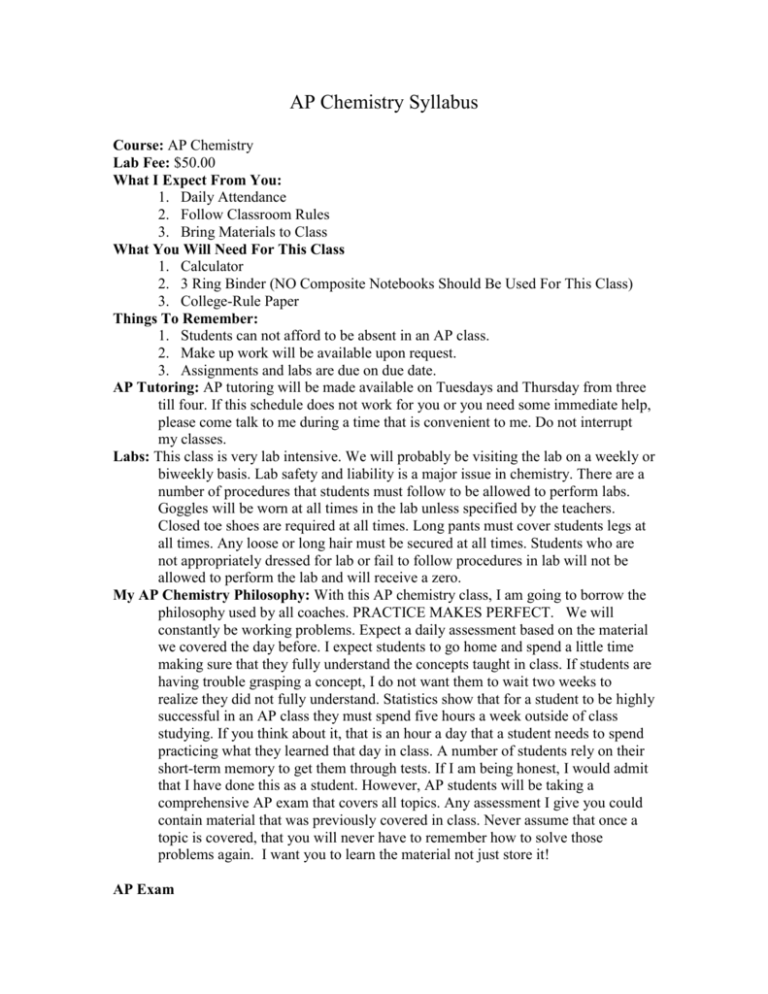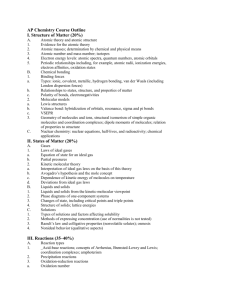AP Chemistry Syllabus - Southside High School
advertisement

AP Chemistry Syllabus Course: AP Chemistry Lab Fee: $50.00 What I Expect From You: 1. Daily Attendance 2. Follow Classroom Rules 3. Bring Materials to Class What You Will Need For This Class 1. Calculator 2. 3 Ring Binder (NO Composite Notebooks Should Be Used For This Class) 3. College-Rule Paper Things To Remember: 1. Students can not afford to be absent in an AP class. 2. Make up work will be available upon request. 3. Assignments and labs are due on due date. AP Tutoring: AP tutoring will be made available on Tuesdays and Thursday from three till four. If this schedule does not work for you or you need some immediate help, please come talk to me during a time that is convenient to me. Do not interrupt my classes. Labs: This class is very lab intensive. We will probably be visiting the lab on a weekly or biweekly basis. Lab safety and liability is a major issue in chemistry. There are a number of procedures that students must follow to be allowed to perform labs. Goggles will be worn at all times in the lab unless specified by the teachers. Closed toe shoes are required at all times. Long pants must cover students legs at all times. Any loose or long hair must be secured at all times. Students who are not appropriately dressed for lab or fail to follow procedures in lab will not be allowed to perform the lab and will receive a zero. My AP Chemistry Philosophy: With this AP chemistry class, I am going to borrow the philosophy used by all coaches. PRACTICE MAKES PERFECT. We will constantly be working problems. Expect a daily assessment based on the material we covered the day before. I expect students to go home and spend a little time making sure that they fully understand the concepts taught in class. If students are having trouble grasping a concept, I do not want them to wait two weeks to realize they did not fully understand. Statistics show that for a student to be highly successful in an AP class they must spend five hours a week outside of class studying. If you think about it, that is an hour a day that a student needs to spend practicing what they learned that day in class. A number of students rely on their short-term memory to get them through tests. If I am being honest, I would admit that I have done this as a student. However, AP students will be taking a comprehensive AP exam that covers all topics. Any assessment I give you could contain material that was previously covered in class. Never assume that once a topic is covered, that you will never have to remember how to solve those problems again. I want you to learn the material not just store it! AP Exam In May, students will have the opportunity to take the AP exam for chemistry. Exam results will be scored as a number one through five. These scores are indicators for colleges on the performance of the student. Depending of the students score, they could receive college credit, advanced placement, or both when they enter college. AP Grade 5 4 3 2 1 Qualification Extremely well qualified Well qualified Qualified Possibly qualified No recommendation. Content Areas: The content areas we will be covering are listed below as well as important topics within each of the five major categories. I. Structure of Matter (20%) A. Atomic theory and atomic structure 1. Evidence for the atomic theory 2. Atomic masses; determination by chemical and physical means 3. Atomic number and mass number; isotopes 4. Electron energy levels: atomic spectra, quantum numbers, atomic orbitals 5. Periodic relationships including, for example, atomic radii, ionization energies, electron affinities, oxidation states B. Chemical bonding 1. Binding forces a. Types: ionic, covalent, metallic, hydrogen bonding, van der (including London dispersion forces) b. Relationships to states, structure, and properties of matter c. Polarity of bonds, electronegativities 2. Molecular models a. Lewis structures b. Valence bond: hybridization of orbitals, resonance, sigma and pi bonds c. VSEPR 3. Geometry of molecules and ions, structural isomerism of simple organic molecules and coordination complexes; dipole moments of molecules; relation of properties to structure C. Nuclear chemistry: nuclear equations, half-lives, and radioactivity; chemical applications II. States of Matter (20%) A. Gases 1. Laws of ideal gases a. Equation of state for an ideal gas b. Partial pressures 2. Kinetic molecular theory a. Interpretation of ideal gas laws on the basis of this theory b. Avogadro’s hypothesis and the mole concept c. Dependence of kinetic energy of molecules on temperature d. Deviations from ideal gas laws B. Liquids and solids 1. Liquids and solids from the kinetic-molecular viewpoint 2. Phase diagrams of one-component systems 3. Changes of state, including critical points and triple points 4. Structure of solids; lattice energies C. Solutions 1. Types of solutions and factors affecting solubility 2. Methods of expressing concentration (use of normalities is not tested) 3. Raoult’s law and colligative properties (nonvolatile solutes); osmosis 4. Nonideal behavior (qualitative aspects) III. Reactions (35–40%) A. Reaction types 1. Acid-base reactions; concepts of Arrhenius, Brønsted-Lowry and Lewis; coordination complexes; amphoterism 2. Precipitation reactions 3. Oxidation-reduction reactions a. Oxidation number b. The role of the electron in oxidation-reduction c. Electrochemistry: electrolytic and galvanic cells; Faraday’s laws; standard half-cell potentials; Nernst equation; prediction of the direction of redox reactions B. Stoichiometry 1. Ionic and molecular species present in chemical systems: net ionic equations 2. Balancing of equations, including those for redox reactions 3. Mass and volume relations with emphasis on the mole concept, including empirical formulas and limiting reactants C. Equilibrium 1. Concept of dynamic equilibrium, physical and chemical; Le Chatelier’s principle; equilibrium constants 2. Quantitative treatment a. Equilibrium constants for gaseous reactions: Kp, Kc b. Equilibrium constants for reactions in solution (1) Constants for acids and bases; pK; pH (2) Solubility product constants and their application to precipitation and the dissolution of slightly soluble compounds (3) Common ion effect; buffers; hydrolysis D. Kinetics 1. Concept of rate of reaction 2. Use of experimental data and graphical analysis to determine reactant order, rate constants and reaction rate laws 3. Effect of temperature change on rates 4. Energy of activation; the role of catalysts 5. The relationship between the rate-determining step and a mechanism E. Thermodynamics 1. State functions 2. First law: change in enthalpy; heat of formation; heat of reaction; Hess’s law; heats of vaporization and fusion; calorimetry 3. Second law: entropy; free energy of formation; free energy of reaction; dependence of change in free energy on enthalpy and entropy changes 4. Relationship of change in free energy to equilibrium constants and electrode potentials IV. Descriptive Chemistry (10–15%) Knowledge of specific facts of chemistry is essential for an understanding of principles and concepts. These descriptive facts, including the chemistry involved in environmental and societal issues, should not be isolated from the principles being studied but should be taught throughout the course to illustrate and illuminate the principles. The following areas should be covered: 1. Chemical reactivity and products of chemical reactions 2. Relationships in the periodic table: horizontal, vertical and diagonal with examples from alkali metals, alkaline earth metals, halogens and the first series of transition elements 3. Introduction to organic chemistry: hydrocarbons and functional groups (structure, nomenclature, chemical properties) V. Laboratory (5–10%) The differences between college chemistry and the usual secondary school chemistry course are especially evident in the laboratory work. The AP Chemistry Exam includes some questions based on experiences and skills students acquire in the laboratory: • making observations of chemical reactions and substances • recording data • calculating and interpreting results based on the quantitative data obtained • communicating effectively the results of experimental work Our Schedule: Since this class is AP, it will meet all year long.






